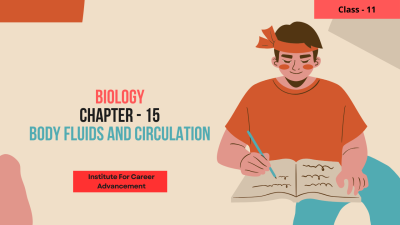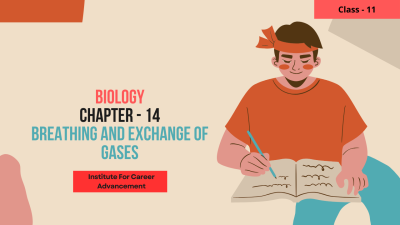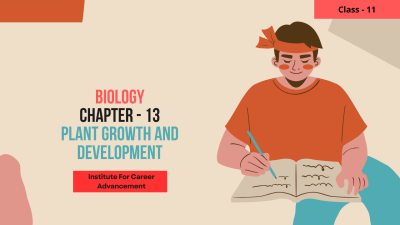Courses


 Compare
Compare
In Class 11 Biology, Chemical Coordination and Integration dives into the fascinating world of hormones! It explores how these chemical messengers act as a long-distance communication network within your body, coordinating and regulating various functions. Here's a quick breakdown: The Mighty Messengers: Learn about hormones, chemical substances produced by glands and transported by the bloodstream to target organs. Diversity of Duties: Explore how different hormones regulate a wide range of functions, including growth, development, metabolism, reproduction, and even your mood! The Glands in Charge: Discover the endocrine system, a network of glands (like the pituitary, thyroid, and pancreas) responsible for hormone production. Lock and Key Specificity: Understand how hormones interact with specific receptors on target cells, triggering a cascade of effects. Maintaining Balance: Learn how hormones work together to maintain homeostasis (internal balance) within the body. Examples in Action: Explore the functions of specific hormones like insulin, thyroxine, and adrenaline to understand their impact on various bodily processes. একাদশ শ্রেণিতে জীববিজ্ঞানে, রাসায়নিক সমন্বয় এবং সংহতকরণ হরমোনের আকর্ষণীয় জগতে ডুব দেয়! এটি অনুসন্ধান করে যে কীভাবে এই রাসায়নিক বার্তাবাহকগুলি আপনার শরীরের মধ্যে দীর্ঘ দূরত্বের যোগাযোগ নেটওয়ার্ক হিসাবে কাজ করে, বিভিন্ন ক্রিয়াকলাপের সমন্বয় ও নিয়ন্ত্রণ করে। এখানে একটি দ্রুত ভাঙ্গনঃ শক্তিশালী বার্তাবাহকগণঃ হরমোন, গ্রন্থি দ্বারা উৎপাদিত রাসায়নিক পদার্থ এবং রক্ত প্রবাহ দ্বারা লক্ষ্য অঙ্গগুলিতে পরিবাহিত হওয়া সম্পর্কে জানুন। কর্তব্যের বৈচিত্র্যঃ বিভিন্ন হরমোন কীভাবে বৃদ্ধি, বিকাশ, বিপাক, প্রজনন এবং এমনকি আপনার মেজাজ সহ বিভিন্ন ধরণের ক্রিয়াকলাপ নিয়ন্ত্রণ করে তা অন্বেষণ করুন! গ্রন্থিগুলি দায়িত্বশীলঃ হরমোন উৎপাদনের জন্য দায়ী গ্রন্থিগুলির (পিটুইটারি, থাইরয়েড এবং অগ্ন্যাশয়ের মতো) একটি নেটওয়ার্ক, অন্তঃস্রাবী ব্যবস্থা আবিষ্কার করুন। লক এবং কী-এর সুনির্দিষ্টতাঃ লক্ষ্য কোষে নির্দিষ্ট রিসেপ্টরগুলির সাথে হরমোনগুলি কীভাবে যোগাযোগ করে তা বুঝুন, যা প্রভাবগুলির একটি ক্যাসকেডকে ট্রিগার করে। ভারসাম্য বজায় রাখাঃ শরীরের মধ্যে হোমিওস্ট্যাসিস (অভ্যন্তরীণ ভারসাম্য) বজায় রাখতে হরমোনগুলি কীভাবে একসাথে কাজ করে তা শিখুন। কর্মের উদাহরণঃ বিভিন্ন শারীরিক প্রক্রিয়ার উপর তাদের প্রভাব বোঝার জন্য ইনসুলিন, থাইরক্সিন এবং অ্যাড্রিনালিনের মতো নির্দিষ্ট হরমোনের কার্যকারিতা অন্বেষণ করুন।
0 Lessons
Hours

 Compare
Compare
The title you provided, "Neutral Control And Co-ordination - Class 18," likely contains a typo. In recent NCERT Biology curriculums, class 18 covers "Neural Control and Coordination." This topic delves into the fascinating world of how your nervous system acts as the master control center, coordinating and regulating all bodily functions. Here's a quick breakdown of what you'll learn: The Mighty Nervous System: Uncover the structure and function of the nervous system, including neurons (nerve cells) that transmit information throughout the body. The Power of Neurons: Explore how neurons communicate with each other using electrical signals and chemical messengers (neurotransmitters). Maintaining Balance: Learn how the nervous system works to maintain homeostasis (internal balance) by regulating processes like body temperature, heart rate, and blood pressure. Voluntary vs. Involuntary Actions: Understand the difference between voluntary actions (conscious control) and involuntary actions (automatic responses) coordinated by the nervous system. Reflexes: Quick Reactions: Discover how reflexes, like pulling your hand away from a hot object, are rapid, involuntary responses coordinated by the nervous system. The Sensory World: Explore how sensory organs (eyes, ears, nose, tongue, skin) detect stimuli from the environment and send signals to the brain for processing. Brain Power: Learn about the different parts of the brain and their roles in functions like movement, sensation, memory, and thinking. আপনি যে শিরোনামটি দিয়েছেন, "নিরপেক্ষ নিয়ন্ত্রণ ও সমন্বয়-ক্লাস 18", সম্ভবত একটি টাইপো রয়েছে। সাম্প্রতিক এন. সি. ই. আর. টি জীববিজ্ঞান পাঠ্যক্রমগুলিতে, 18 তম শ্রেণীতে "স্নায়বিক নিয়ন্ত্রণ এবং সমন্বয়" অন্তর্ভুক্ত রয়েছে। এই বিষয়টি আপনার স্নায়ুতন্ত্র কীভাবে প্রধান নিয়ন্ত্রণ কেন্দ্র হিসাবে কাজ করে, সমস্ত শারীরিক ক্রিয়াকলাপকে সমন্বয় ও নিয়ন্ত্রণ করে তার আকর্ষণীয় জগতে প্রবেশ করে। আপনি যা শিখবেন তার একটি দ্রুত বিবরণ এখানে দেওয়া হলঃ শক্তিশালী স্নায়ুতন্ত্রঃ স্নায়ুতন্ত্রের কাঠামো এবং কার্যকারিতা আবিষ্কার করুন, যার মধ্যে নিউরন (স্নায়ু কোষ) রয়েছে যা সারা শরীর জুড়ে তথ্য প্রেরণ করে। নিউরনগুলির শক্তিঃ বৈদ্যুতিক সংকেত এবং রাসায়নিক বার্তাবাহক ব্যবহার করে নিউরনগুলি কীভাবে একে অপরের সাথে যোগাযোগ করে তা অন্বেষণ করুন (neurotransmitters). ভারসাম্য বজায় রাখাঃ শরীরের তাপমাত্রা, হৃদস্পন্দন এবং রক্তচাপের মতো প্রক্রিয়াগুলি নিয়ন্ত্রণ করে স্নায়ুতন্ত্র কীভাবে হোমিওস্ট্যাসিস (অভ্যন্তরীণ ভারসাম্য) বজায় রাখতে কাজ করে তা শিখুন। স্বেচ্ছাসেবী বনাম। অনিচ্ছাকৃত ক্রিয়াঃ স্নায়ুতন্ত্র দ্বারা সমন্বিত স্বেচ্ছাসেবী ক্রিয়া (সচেতন নিয়ন্ত্রণ) এবং অনিচ্ছাকৃত ক্রিয়া (স্বয়ংক্রিয় প্রতিক্রিয়া) এর মধ্যে পার্থক্য বুঝুন। প্রতিচ্ছবিঃ দ্রুত প্রতিক্রিয়াঃ আবিষ্কার করুন কিভাবে রিফ্লেক্স, যেমন একটি গরম বস্তু থেকে আপনার হাত দূরে টানতে, স্নায়ুতন্ত্র দ্বারা সমন্বিত দ্রুত, অনিচ্ছাকৃত প্রতিক্রিয়া। সংবেদনশীল বিশ্বঃ সংবেদনশীল অঙ্গগুলি (চোখ, কান, নাক, জিহ্বা, ত্বক) কীভাবে পরিবেশ থেকে উদ্দীপনা সনাক্ত করে এবং প্রক্রিয়াকরণের জন্য মস্তিষ্কে সংকেত প্রেরণ করে তা অন্বেষণ করুন। মস্তিষ্কের শক্তিঃ মস্তিষ্কের বিভিন্ন অংশ এবং চলাচল, সংবেদনশীলতা, স্মৃতি এবং চিন্তাভাবনার মতো ক্রিয়াকলাপে তাদের ভূমিকা সম্পর্কে জানুন।
0 Lessons
Hours

 Compare
Compare
From slithering snakes to sprinting cheetahs, movement is everywhere in the animal kingdom! In Class 11 Biology, you'll delve into the fascinating world of Locomotion and Movement, exploring how organisms of all shapes and sizes get around. The Big Picture: Movement vs. Locomotion: Learn the difference! Movement is any change in body position, while locomotion is movement that leads to a change in location. The Players: Discover the variety of structures and mechanisms that different organisms use for movement, like muscles, cilia, flagella, and even pseudopodia in amoebas! Types of Movement: The Three Main Movers: Explore the three major categories of movement: Amoeboid Movement: The ever-changing shape shifting of amoebas for movement. Ciliary and Flagellar Movement: Microscopic hair-like structures that propel organisms or move fluids within them. Muscular Movement: The powerhouse behind most complex movements in animals, including humans. Let's Get Moving - The Human Body: Muscles: The Engine: Unravel the structure and function of different muscle types (skeletal, smooth, cardiac) and how they work together to generate movement. The Skeletal System: The Framework: Explore how bones and joints provide a framework for muscles to act upon and facilitate coordinated movement. The Nervous System: The Control Center: Learn how the nervous system coordinates muscle activity and sends signals for movement. Why It Matters: From Finding Food to Escaping Predators: Locomotion is essential for survival, allowing organisms to find resources, escape danger, and reproduce. The Importance of Coordination: Understanding how different systems work together for movement highlights the interconnectedness of life processes. সরানো সাপ থেকে শুরু করে দ্রুতগতির চিতা পর্যন্ত, প্রাণীজগতের সর্বত্রই চলাচল রয়েছে! একাদশ শ্রেণিতে জীববিজ্ঞানে, আপনি লোকোমোশন এবং মুভমেন্টের আকর্ষণীয় জগতে প্রবেশ করবেন, কীভাবে সমস্ত আকার এবং আকারের জীবগুলি চারপাশে আসে তা অন্বেষণ করবেন। বড় ছবিঃ মুভমেন্ট বনাম লোকোমোশনঃ পার্থক্য শিখুন! নড়াচড়া হল শরীরের অবস্থানের যে কোনও পরিবর্তন, অন্যদিকে নড়াচড়া হল এমন নড়াচড়া যা অবস্থানের পরিবর্তনের দিকে পরিচালিত করে। খেলোয়াড়রাঃ পেশী, সিলিয়া, ফ্লাজেলা এবং এমনকি অ্যামিবা-র সিউডোপোডিয়ার মতো বিভিন্ন জীব চলাচলের জন্য যে বিভিন্ন কাঠামো এবং প্রক্রিয়া ব্যবহার করে তা আবিষ্কার করুন! চলাফেরার প্রকারঃ তিনটি প্রধান মুভারঃ চলাচলের তিনটি প্রধান বিভাগ অন্বেষণ করুনঃ অ্যামিবয়েড মুভমেন্টঃ চলাচলের জন্য অ্যামিবাগুলির চির-পরিবর্তনশীল আকৃতি স্থানান্তর। সিলিয়ারি এবং ফ্ল্যাজেলার মুভমেন্টঃ মাইক্রোস্কোপিক চুলের মতো কাঠামো যা জীবকে চালিত করে বা তাদের মধ্যে তরল স্থানান্তর করে। পেশী চলাচলঃ মানুষ সহ প্রাণীদের মধ্যে সবচেয়ে জটিল চলাফেরার পিছনে পাওয়ার হাউস। চলুন নড়াচড়া করি-মানবদেহঃ পেশীঃ ইঞ্জিনঃ বিভিন্ন ধরনের পেশী (কঙ্কাল, মসৃণ, কার্ডিয়াক) এর গঠন এবং কার্যকারিতা এবং কীভাবে তারা আন্দোলন তৈরি করতে একসাথে কাজ করে তা উন্মোচন করুন। স্কেলেটাল সিস্টেমঃ কাঠামোঃ হাড় এবং জয়েন্টগুলি কীভাবে পেশীগুলিকে কাজ করার জন্য একটি কাঠামো সরবরাহ করে এবং সমন্বিত চলাচলকে সহজতর করে তা অন্বেষণ করুন। স্নায়ুতন্ত্রঃ নিয়ন্ত্রণ কেন্দ্রঃ শিখুন কিভাবে স্নায়ুতন্ত্র পেশী ক্রিয়াকলাপের সমন্বয় করে এবং চলাফেরার জন্য সংকেত পাঠায়। কেন এটি গুরুত্বপূর্ণঃ খাদ্যের সন্ধান থেকে শুরু করে শিকারীদের এড়িয়ে যাওয়া পর্যন্তঃ বেঁচে থাকার জন্য লোকোমোশন অপরিহার্য, যা জীবকে সম্পদ খুঁজে পেতে, বিপদ থেকে বাঁচতে এবং পুনরুত্পাদন করতে দেয়। সমন্বয়ের গুরুত্বঃ চলাফেরার জন্য বিভিন্ন ব্যবস্থা কীভাবে একসাথে কাজ করে তা বোঝা জীবন প্রক্রিয়াগুলির আন্তঃসংযোগকে তুলে ধরে।
0 Lessons
Hours

 Compare
Compare
Your body is a busy city, constantly working and producing waste! But unlike throwing things away, your body has a special way to get rid of unwanted materials. In Class 11 Biology, you'll explore the fascinating world of Excretory Products and Their Elimination, learning how your body efficiently removes waste products to stay healthy. The Culprits: Metabolic Waste: As your body breaks down food for energy, it creates byproducts like ammonia, urea, and carbon dioxide. These need to be eliminated. The Disposal Options: Different organisms have evolved various ways to deal with waste. You'll learn about three main categories: Ammonotelic: Ammonia disposal (mostly aquatic animals) Ureotelic: Urea disposal (mammals like us) Uricotelic: Uric acid disposal (birds, reptiles) Your Body's Cleanup Crew: The Excretory System: This amazing system works tirelessly to filter and remove waste products from your blood. The key players include: Kidneys: Filter waste and excess water from blood, producing urine. Lungs: Eliminate carbon dioxide, a gas produced during cellular respiration. Skin: Sweats out excess water, salts, and some waste products. Why It Matters: By eliminating waste, your body maintains a healthy internal environment, preventing buildup of toxic substances and ensuring proper cell function. আপনার শরীর একটি ব্যস্ত শহর, ক্রমাগত কাজ করে এবং বর্জ্য উৎপাদন করে! কিন্তু জিনিসগুলি ফেলে দেওয়ার বিপরীতে, আপনার শরীরের অবাঞ্ছিত পদার্থগুলি থেকে মুক্তি পাওয়ার একটি বিশেষ উপায় রয়েছে। ক্লাস 11 বায়োলজিতে, আপনি বর্জ্য পণ্য এবং তাদের নির্মূলের আকর্ষণীয় জগৎটি অন্বেষণ করবেন, শিখবেন কিভাবে আপনার শরীর সুস্থ থাকার জন্য বর্জ্য পণ্যগুলি দক্ষতার সাথে সরিয়ে দেয়। দোষীদেরঃ বিপাকীয় বর্জ্যঃ আপনার শরীর যখন শক্তির জন্য খাবার ভেঙে দেয়, তখন এটি অ্যামোনিয়া, ইউরিয়া এবং কার্বন ডাই অক্সাইডের মতো উপজাত তৈরি করে। এগুলো দূর করতে হবে। নিষ্পত্তি বিকল্পগুলিঃ বিভিন্ন জীব বর্জ্য মোকাবেলার জন্য বিভিন্ন উপায় উদ্ভাবন করেছে। আপনি তিনটি প্রধান বিভাগ সম্পর্কে শিখবেনঃ অ্যামোনোটেলিকঃ অ্যামোনিয়া অপসারণ (mostly aquatic animals) ইউরিওটেলিকঃ ইউরিয়া অপসারণ (mammals like us) ইউরিকোটেলিকঃ ইউরিক অ্যাসিড নিষ্কাশন (birds, reptiles) আপনার দেহের পরিচ্ছন্নতার কর্মীদলঃ বর্জ্য ব্যবস্থাঃ এই বিস্ময়কর ব্যবস্থাটি আপনার রক্ত থেকে বর্জ্য পদার্থগুলি ফিল্টার এবং অপসারণ করতে অক্লান্ত পরিশ্রম করে। মূল খেলোয়াড়দের মধ্যে রয়েছেঃ কিডনিঃ রক্ত থেকে বর্জ্য এবং অতিরিক্ত জল ফিল্টার করে প্রস্রাব তৈরি করে। ফুসফুসঃ কার্বন ডাই অক্সাইড দূর করে, যা কোষীয় শ্বাস-প্রশ্বাসের সময় উৎপাদিত একটি গ্যাস। ত্বকঃ অতিরিক্ত জল, লবণ এবং কিছু বর্জ্য পদার্থ ঘাম ঝরিয়ে দেয়। কেন এটি গুরুত্বপূর্ণঃ বর্জ্য অপসারণের মাধ্যমে, আপনার শরীর একটি স্বাস্থ্যকর অভ্যন্তরীণ পরিবেশ বজায় রাখে, বিষাক্ত পদার্থের গঠন প্রতিরোধ করে এবং সঠিক কোষের কার্যকারিতা নিশ্চিত করে।
0 Lessons
Hours

 Compare
Compare
Your body is like a bustling city with constant traffic! But instead of cars, it's fluids that keep everything running smoothly. In Class 11 Biology, you'll delve into the world of Body Fluids and Circulation, exploring the essential fluids and the amazing circulatory system that transports them throughout your body. The Players: Blood: The star of the show! Blood is a fluid tissue made up of plasma (the liquid part) and cells like red blood cells (carry oxygen), white blood cells (fight infection), and platelets (help with clotting). Lymph: The lesser-known hero! Lymph is a fluid that collects waste products and transports them to the bloodstream. The Highway System: Circulatory System: This complex network of blood vessels (arteries, veins, and capillaries) carries blood throughout the body. Double Circulation: Unlike some simpler systems, humans have a double circulation system. Blood passes through the heart twice in one complete circuit, ensuring efficient delivery of oxygen and nutrients. Keeping Things Moving: The Heart: The powerful pump that keeps blood flowing through the circulatory system. Why It Matters: This intricate system is vital for delivering oxygen, nutrients, and hormones to all your cells and tissues. It also removes waste products and helps regulate body temperature. আপনার শরীর যেন একটানা যানজটের শহর! কিন্তু গাড়ির পরিবর্তে, তরল পদার্থই সবকিছু মসৃণভাবে চালিয়ে যায়। ক্লাস 11 বায়োলজিতে, আপনি দেহের তরল এবং সঞ্চালনের জগতে প্রবেশ করবেন, প্রয়োজনীয় তরল এবং আশ্চর্যজনক সংবহন ব্যবস্থা অন্বেষণ করবেন যা সেগুলিকে আপনার সারা শরীর জুড়ে পরিবহন করে। খেলোয়াড়রাঃ রক্তঃ দ্য স্টার অফ দ্য শো! রক্ত হল একটি তরল টিস্যু যা প্লাজমা (তরল অংশ) এবং লোহিত রক্তকণিকা (অক্সিজেন বহনকারী) শ্বেত রক্তকণিকা (সংক্রমণের বিরুদ্ধে লড়াই) এবং প্লেটলেট দ্বারা গঠিত। (help with clotting). লিম্ফঃ কম পরিচিত নায়ক! লিম্ফ হল একটি তরল যা বর্জ্য পদার্থ সংগ্রহ করে এবং সেগুলিকে রক্ত প্রবাহে পরিবহন করে। মহাসড়ক ব্যবস্থাঃ রক্ত সঞ্চালন ব্যবস্থাঃ রক্তবাহী জাহাজের এই জটিল নেটওয়ার্ক (ধমনী, শিরা এবং কৈশিক) সারা শরীর জুড়ে রক্ত বহন করে। ডাবল সার্কুলেশনঃ কিছু সহজ পদ্ধতির বিপরীতে, মানুষের একটি ডাবল সার্কুলেশন ব্যবস্থা রয়েছে। রক্ত একটি সম্পূর্ণ বর্তনীতে হৃৎপিণ্ডের মধ্য দিয়ে দুবার যায়, যা অক্সিজেন এবং পুষ্টির দক্ষ বিতরণ নিশ্চিত করে। জিনিসগুলি সচল রাখাঃ হার্টঃ শক্তিশালী পাম্প যা রক্ত সঞ্চালন ব্যবস্থার মধ্য দিয়ে প্রবাহিত রাখে। কেন এটি গুরুত্বপূর্ণঃ এই জটিল ব্যবস্থাটি আপনার সমস্ত কোষ এবং টিস্যুতে অক্সিজেন, পুষ্টি এবং হরমোন সরবরাহের জন্য অত্যাবশ্যক। এটি বর্জ্য পদার্থও অপসারণ করে এবং শরীরের তাপমাত্রা নিয়ন্ত্রণ করতে সহায়তা করে।
0 Lessons
Hours

 Compare
Compare
All living things need oxygen to survive, and plants are no exception! But unlike us animals with lungs, plants have a different way to breathe. Here's a quick look at how gas exchange works in plants for Class 11: The Need for Air: Plants use oxygen (O₂) for cellular respiration, just like us. They also release carbon dioxide (CO₂) as a waste product during this process. No Lungs, No Problem: Plants don't have lungs, but they have tiny pores on their leaves called stomata (singular: stoma) and similar structures on stems called lenticels. These pores act like microscopic air vents for gas exchange. The Breathing Process: Taking in Oxygen: During the day, stomata open to allow oxygen from the atmosphere to diffuse into the plant. Releasing Carbon Dioxide: At the same time, carbon dioxide produced by cellular respiration diffuses out of the plant through the stomata and lenticels. The CO₂ Twist: This released CO₂ is actually used by plants themselves for photosynthesis during the day! It's a cool recycling trick. Factors at Play: Light, temperature, and water availability can all influence how much a plant "breathes" by affecting the opening and closing of stomata. The Takeaway: Even though breathing in plants seems simpler than in animals, it's an essential process for their survival and growth. It's all about taking in what they need and getting rid of waste! সব জীবের বেঁচে থাকার জন্য অক্সিজেনের প্রয়োজন, এবং গাছপালাও এর ব্যতিক্রম নয়! প্রাণীদের থেকে ভিন্ন, উদ্ভিদের শ্বাস-প্রশ্বাসের পদ্ধতি আলাদা। ক্লাস 11-এর জন্য কারখানাগুলিতে গ্যাস এক্সচেঞ্জ কীভাবে কাজ করে তা এখানে দ্রুত দেখুনঃ বাতাসের প্রয়োজনীয়তাঃ উদ্ভিদ আমাদের মতো কোষীয় শ্বাস-প্রশ্বাসের জন্য অক্সিজেন (O2) ব্যবহার করে। তারা এই প্রক্রিয়া চলাকালীন বর্জ্য পণ্য হিসাবে কার্বন ডাই অক্সাইড (সিও 2) ছেড়ে দেয়। কোন সমস্যা নেই, কোন সমস্যা নেইঃ উদ্ভিদের ফুসফুস নেই, তবে তাদের পাতায় ছোট ছোট ছিদ্র রয়েছে যা স্টোমাটা (একবচনঃ স্টোমা) এবং কান্ডের উপর অনুরূপ কাঠামো রয়েছে যাকে লেন্টিসেল বলা হয়। এই ছিদ্রগুলি গ্যাস বিনিময়ের জন্য মাইক্রোস্কোপিক বায়ু ভেন্টের মতো কাজ করে। শ্বাস-প্রশ্বাসের প্রক্রিয়াঃ অক্সিজেন গ্রহণঃ দিনের বেলায়, বায়ুমণ্ডল থেকে অক্সিজেনকে উদ্ভিদে ছড়িয়ে দেওয়ার জন্য স্টোমাটা খোলা থাকে। কার্বন ডাই অক্সাইড মুক্ত করাঃ একই সময়ে, কোষীয় শ্বসন দ্বারা উত্পাদিত কার্বন ডাই অক্সাইড উদ্ভিদ থেকে স্টোমাটা এবং মসুর ডালের মাধ্যমে ছড়িয়ে পড়ে। CO2 টুইস্টঃ এই মুক্ত CO2 আসলে উদ্ভিদ দ্বারা দিনের বেলা সালোকসংশ্লেষণের জন্য ব্যবহার করা হয়! এটি একটি চমৎকার পুনর্ব্যবহারযোগ্য কৌশল। খেলার কারণগুলিঃ আলো, তাপমাত্রা এবং জলের সহজলভ্যতা স্টোমাটার খোলার এবং বন্ধকে প্রভাবিত করে একটি উদ্ভিদ কতটা "শ্বাস নেয়" তা প্রভাবিত করতে পারে। গ্রহণযোগ্যঃ যদিও প্রাণীদের তুলনায় উদ্ভিদের শ্বাস-প্রশ্বাস সহজ বলে মনে হয়, এটি তাদের বেঁচে থাকার এবং বৃদ্ধির জন্য একটি অপরিহার্য প্রক্রিয়া। এগুলি হল তাদের যা প্রয়োজন তা গ্রহণ করা এবং বর্জ্য অপসারণ করা!
0 Lessons
Hours

 Compare
Compare
Plants don't just sprout and magically grow! They go through a fascinating process called plant growth and development, which is all about how they increase in size and complexity. This journey is influenced by both internal factors, like special plant hormones, and external factors, like the amount of sunshine they get. Here's a quick look at what you'll discover in Plant Growth and Development for Class 11: The Growth Engine: Meristems Imagine tiny factories inside a plant. These are meristems, regions packed with cells that constantly divide, creating new cells for growth. They're located at the tips of roots and shoots, like little building crews constantly expanding the plant. Two Types of Growth: Lengthwise Stretch: This is primary growth, driven by meristems at the tips, making the plant shoot up and roots dig deeper. Getting Thicker: Secondary growth involves special sideways-growing meristems that add layers of woody tissue, making the plant stronger and wider. Hormonal Control Center Plants don't have brains, but they use chemical messengers called hormones to control growth. Auxin, for example, helps stems grow tall, while other hormones influence root development, leaf growth, and even when leaves fall off. The Environment Matters Light, temperature, and water availability all play a big role in how plants grow. Sunlight fuels photosynthesis for energy, while the right temperature keeps things running smoothly. Water is essential for everything from keeping cells plump to transporting nutrients. From Seed to Plant The journey starts with seed germination, where a tiny seed breaks open and starts to grow into a seedling under the right conditions. Plants can even respond to the day/night cycle (photoperiodism) to know when to flower! গাছপালা কেবল অঙ্কুরিত হয় না এবং জাদুকরীভাবে বৃদ্ধি পায় না! তারা উদ্ভিদের বৃদ্ধি এবং বিকাশ নামে একটি আকর্ষণীয় প্রক্রিয়ার মধ্য দিয়ে যায়, যা কীভাবে তারা আকার এবং জটিলতা বৃদ্ধি করে সে সম্পর্কে। এই যাত্রাটি উদ্ভিদের বিশেষ হরমোনের মতো অভ্যন্তরীণ কারণ এবং সূর্যালোকের পরিমাণের মতো বাহ্যিক কারণ উভয়ের দ্বারা প্রভাবিত হয়। ক্লাস 11-এর জন্য উদ্ভিদ বৃদ্ধি এবং বিকাশে আপনি কী আবিষ্কার করবেন তা এখানে একটি দ্রুত চেহারা দেওয়া হলঃ বৃদ্ধির ইঞ্জিনঃ মেরিস্টেমস একটি কারখানার ভিতরে ছোট ছোট কারখানার কথা কল্পনা করুন। এগুলি মেরিস্টেম, কোষ দ্বারা পূর্ণ অঞ্চল যা ক্রমাগত বিভক্ত হয়, বৃদ্ধির জন্য নতুন কোষ তৈরি করে। এগুলি শিকড় এবং অঙ্কুরের ডগায় অবস্থিত, যেমন ছোট বিল্ডিং ক্রুরা ক্রমাগত উদ্ভিদটি প্রসারিত করে। দুই ধরনের বৃদ্ধিঃ দৈর্ঘ্যের দিকের প্রসারঃ এটি প্রাথমিক বৃদ্ধি, যা অগ্রভাগে মেরিস্টেম দ্বারা চালিত হয়, যার ফলে উদ্ভিদটি অঙ্কুরিত হয় এবং শিকড়গুলি আরও গভীর খনন করে। পুরু হওয়াঃ গৌণ বৃদ্ধিতে বিশেষ পার্শ্ব-ক্রমবর্ধমান মেরিস্টেম জড়িত থাকে যা কাঠের টিস্যুর স্তর যুক্ত করে, উদ্ভিদকে আরও শক্তিশালী এবং প্রশস্ত করে তোলে। হরমোন নিয়ন্ত্রণ কেন্দ্র উদ্ভিদের মস্তিষ্ক নেই, তবে তারা বৃদ্ধি নিয়ন্ত্রণ করতে হরমোন নামক রাসায়নিক বার্তাবাহক ব্যবহার করে। উদাহরণস্বরূপ, অক্সিন কান্ডগুলিকে লম্বা হতে সাহায্য করে, অন্যদিকে অন্যান্য হরমোনগুলি শিকড়ের বিকাশ, পাতার বৃদ্ধি এবং এমনকি পাতা পড়ে যাওয়ার সময়ও প্রভাবিত করে। পরিবেশের বিষয়গুলি উদ্ভিদের বৃদ্ধিতে আলো, তাপমাত্রা এবং জলের প্রাপ্যতা সবই একটি বড় ভূমিকা পালন করে। সূর্যালোক শক্তির জন্য সালোকসংশ্লেষণে ইন্ধন যোগায়, অন্যদিকে সঠিক তাপমাত্রা জিনিসগুলিকে মসৃণভাবে চলতে রাখে। কোষগুলিকে মোটা রাখা থেকে শুরু করে পুষ্টি পরিবহণ পর্যন্ত সবকিছুর জন্য জল অপরিহার্য। বীজ থেকে গাছে যাত্রাটি শুরু হয় বীজের অঙ্কুরোদগমের মাধ্যমে, যেখানে একটি ক্ষুদ্র বীজ ভেঙে যায় এবং সঠিক পরিস্থিতিতে একটি চারায় পরিণত হতে শুরু করে। গাছপালা এমনকি দিন/রাতের চক্রের (ফটোপেরিওডিজম) প্রতি সাড়া দিয়ে জানতে পারে যে কখন ফুল ফোটে!
0 Lessons
Hours

 Compare
Compare
Plants aren't just breathers of fresh air, they're also secret breathers themselves! Unlike animals, plants don't have lungs, but they do undergo respiration. Here's a quick look: The Need for Energy: Just like us, plants require energy for various functions like growth, repair, and nutrient uptake. Respiration is the process by which they break down organic molecules (usually sugars made during photosynthesis) to release this energy. Not Just About Oxygen: While plants do take in oxygen (O₂) during respiration, they don't have a specialized breathing system. Tiny pores on leaves (stomata) and stems (lenticels) allow for gas exchange. Unlike photosynthesis, respiration happens in all living plant parts – leaves, stems, and even roots. The Release: The breakdown of sugars in respiration releases carbon dioxide (CO₂) as a waste product, which then diffuses back out through the stomata and lenticels. This CO₂ isn't necessarily "bad" – it's actually used by plants themselves for photosynthesis during the day! The Takeaway: Respiration in plants is an essential process, even though it seems to work against photosynthesis. It's a cellular mechanism that provides plants with the energy they need to survive and function, even during the night when photosynthesis isn't happening. গাছপালা কেবল তাজা বাতাসের নিঃশ্বাস নয়, তারা নিজেরাই গোপন শ্বাস-প্রশ্বাসও! প্রাণীদের মতো, উদ্ভিদের ফুসফুস নেই, তবে তারা শ্বাস-প্রশ্বাসের মধ্য দিয়ে যায়। এখানে একটি দ্রুত দেখুনঃ শক্তির প্রয়োজনীয়তাঃ আমাদের মতো উদ্ভিদেরও বৃদ্ধি, মেরামত এবং পুষ্টি গ্রহণের মতো বিভিন্ন কাজের জন্য শক্তির প্রয়োজন হয়। শ্বাস-প্রশ্বাস হল সেই প্রক্রিয়া যার মাধ্যমে তারা এই শক্তি মুক্ত করার জন্য জৈব অণুগুলি (সাধারণত সালোকসংশ্লেষণের সময় তৈরি শর্করা) ভেঙে দেয়। শুধু অক্সিজেন নয়ঃ যদিও উদ্ভিদগুলি শ্বাস-প্রশ্বাসের সময় অক্সিজেন (O2) গ্রহণ করে, তাদের কোনও বিশেষ শ্বাস-প্রশ্বাস ব্যবস্থা নেই। পাতার ছোট ছিদ্র (স্টোমাটা) এবং কান্ড (লেন্টিসেল) গ্যাস বিনিময়ের অনুমতি দেয়। সালোকসংশ্লেষণের বিপরীতে, সমস্ত জীবন্ত উদ্ভিদ অংশে-পাতা, কাণ্ড এবং এমনকি শিকড়েও শ্বাস-প্রশ্বাস ঘটে। মুক্তিঃ শ্বাসকষ্টে শর্করার ভাঙ্গন বর্জ্য পণ্য হিসাবে কার্বন ডাই অক্সাইড (সিও 2) প্রকাশ করে, যা পরে স্টোমাটা এবং লেন্টিসেলের মাধ্যমে ছড়িয়ে পড়ে। এই সিও2 অপরিহার্যভাবে "খারাপ" নয়-এটি আসলে দিনের বেলায় উদ্ভিদ দ্বারা সালোকসংশ্লেষণের জন্য ব্যবহৃত হয়! দ্য টেকওয়েঃ উদ্ভিদগুলিতে শ্বাস-প্রশ্বাস একটি অপরিহার্য প্রক্রিয়া, যদিও এটি সালোকসংশ্লেষণের বিরুদ্ধে কাজ করে বলে মনে হয়। এটি একটি কোষীয় প্রক্রিয়া যা উদ্ভিদকে বেঁচে থাকার এবং কাজ করার জন্য প্রয়োজনীয় শক্তি সরবরাহ করে, এমনকি রাতের বেলাও যখন সালোকসংশ্লেষণ ঘটছে না।
0 Lessons
Hours

 Compare
Compare
Photosynthesis is the amazing process by which higher plants, like the ones you see every day, use sunlight to fuel the creation of their own food! This food, in the form of sugar molecules, is the foundation of life on Earth. Here's a quick look at what goes on inside a plant to make this magic happen: The site of photosynthesis in a plant cell is the chloroplast. These tiny organelles contain chlorophyll, a pigment that gives plants their green color and plays a starring role in capturing the sun's energy. Two-Stage Spectacle Photosynthesis can be broken down into two main stages: The Light-Dependent Reactions (Light Reactions): Here, sunlight is absorbed by chlorophyll, energizing electrons. This energy is then used to produce ATP (adenosine triphosphate) and NADPH (nicotinamide adenine dinucleotide phosphate), which are the energy currencies used in the next stage. The Light-Independent Reactions (Dark Reactions): Even though light isn't directly required here, these reactions are often referred to as the "dark reactions" because they can happen in low light conditions. In this stage, the ATP and NADPH from the light reactions are used to take carbon dioxide from the air and convert it into sugar molecules (glucose) through a series of enzyme-controlled steps. The Big Picture The sugars produced by photosynthesis are used by the plant for growth, repair, and energy. Additionally, some of the sugar is converted into other organic molecules, such as starches and proteins, which are used for storage and building materials. Photosynthesis is also essential for the release of oxygen gas (O₂) into the atmosphere, which is necessary for most forms of life to survive. সালোকসংশ্লেষণ একটি বিস্ময়কর প্রক্রিয়া যার মাধ্যমে উচ্চতর গাছপালা, যেমন আপনি প্রতিদিন দেখেন, তাদের নিজস্ব খাদ্য তৈরির জন্য সূর্যালোক ব্যবহার করে! চিনির অণু আকারে এই খাদ্য পৃথিবীতে জীবনের ভিত্তি। এই জাদু ঘটানোর জন্য একটি উদ্ভিদের ভিতরে কী চলছে তা এখানে দ্রুত দেখুনঃ উদ্ভিদ কোষে সালোকসংশ্লেষণের স্থান হল ক্লোরোপ্লাস্ট। এই ক্ষুদ্র অর্গানেলগুলিতে ক্লোরোফিল রয়েছে, একটি রঞ্জক যা গাছগুলিকে তাদের সবুজ রঙ দেয় এবং সূর্যের শক্তি ধরে রাখতে একটি প্রধান ভূমিকা পালন করে। দ্বি-পর্যায় প্রদর্শনী সালোকসংশ্লেষণকে দুটি প্রধান পর্যায়ে ভাগ করা যেতে পারেঃ হালকা-নির্ভর বিক্রিয়া (হালকা বিক্রিয়া) এখানে, সূর্যালোক ক্লোরোফিল দ্বারা শোষিত হয়, যা ইলেকট্রনকে শক্তিশালী করে। এই শক্তি তারপর এটিপি (অ্যাডেনোসিন ট্রাইফসফেট) এবং এনএডিপিএইচ (নিকোটিনামাইড অ্যাডেনিন ডাইনুক্লিয়টাইড ফসফেট) উৎপাদনে ব্যবহৃত হয় যা পরবর্তী পর্যায়ে ব্যবহৃত শক্তি মুদ্রা। হালকা-স্বাধীন প্রতিক্রিয়া (অন্ধকার প্রতিক্রিয়া) যদিও এখানে সরাসরি আলোর প্রয়োজন হয় না, তবুও এই প্রতিক্রিয়াগুলিকে প্রায়শই "অন্ধকার প্রতিক্রিয়া" হিসাবে উল্লেখ করা হয় কারণ এগুলি কম আলোতে ঘটতে পারে। এই পর্যায়ে, হালকা প্রতিক্রিয়া থেকে এটিপি এবং এনএডিপিএইচ বায়ু থেকে কার্বন ডাই অক্সাইড নিতে এবং এনজাইম-নিয়ন্ত্রিত পদক্ষেপের মাধ্যমে এটিকে চিনির অণুতে (গ্লুকোজ) রূপান্তর করতে ব্যবহৃত হয়। বড় ছবি সালোকসংশ্লেষণ দ্বারা উৎপাদিত শর্করা উদ্ভিদ দ্বারা বৃদ্ধি, মেরামত এবং শক্তির জন্য ব্যবহৃত হয়। উপরন্তু, কিছু চিনি অন্যান্য জৈব অণুতে রূপান্তরিত হয়, যেমন শ্বেতসার এবং প্রোটিন, যা সঞ্চয় এবং নির্মাণ সামগ্রীর জন্য ব্যবহৃত হয়। বায়ুমণ্ডলে অক্সিজেন গ্যাস (O2) মুক্ত করার জন্য সালোকসংশ্লেষণও অপরিহার্য, যা জীবনের বেশিরভাগ রূপের বেঁচে থাকার জন্য প্রয়োজনীয়।
0 Lessons
Hours